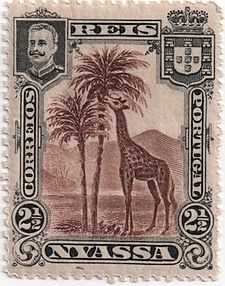Niassa Company
 A stamp issued by the Niassa Company | |
| Industry | International trade |
|---|---|
| Fate | Dissolved |
| Founded | 1890 |
| Defunct | 1929 |
| Headquarters | Cabo Delgado Province and Niassa Province, Portuguese Mozambique, Portuguese Empire |
| Area served | Portuguese Empire |
The Niassa Company (Portuguese: Companhia do Niassa) was a royal company in the Portuguese colony of Mozambique, then known as Portuguese East Africa, that had the concession of the lands that include the present provinces of Cabo Delgado and Niassa between 1891 and 1929.[1]
Origins
In the late 19th century Portugal’s dominance of Mozambique was threatened by Great Britain and Germany, who planned to divide Mozambique between them.
Portugal lacked the capital to colonize Mozambique properly, so it leased the country and its people to others. By 1891 one third of the country was handed over to three British companies, the Mozambique Company, the Zambezi Company and the Niassa Company.
Although founded by Bernard Daupais, a merchant from Lisbon, the Niassa Company was owned by British and French interests.
The company was granted a charter by the Portuguese government to establish economic development and maintain Portuguese control in Niassa Province and Cabo Delgado and was officially incorporated in March 1893.
Territory
The territory of the Niassa Company covered the north of Mozambique, above the river Lurio.
In 1904 the Niassa Company founded the town Porto Amélia, which is presently known as Pemba, and Porto Amélia became the headquarters of the company.
The chibalo system
The power of the Niassa Company was based on the chibalo system, a forced labor policy, which forced the Mozambicans to work on plantations, cotton fields and on public works projects. Additionally Mozambicans were forced to pay hut taxes that kept them in debt. The chibalo system enabled the Niassa Company to establish plantations and to force peasants to work for them and prevent them from growing their own crops for sale.
Demise
The company lost its purpose when its territory was transferred to the control of the Portuguese colonial government on 27 October 1929 after the government refused to grant an extension of its concession.[2]
Although one of its main obligations was to create light houses along the Mozambican Coast, the Niassa Company fell short of this goal.[1]
See also
- Postage stamps and postal history of the Nyassa Company
References
- ↑ 1.0 1.1 Silva Pais, Antonia da; translated from French by Michel Forand. "Lighthouse Development in Mozambique, 1908-1931". Web Page of The University of North Carolina at Chapel Hill. University of North Carolina at Chapel Hill. Retrieved 2007-03-14.
- ↑ Neil-Tomlinson, Barry (1999). "The Nyassa Chartered Company: 1891-1929". The Journal of African History 18 (1): 109. doi:10.1017/S0021853700015255. JSTOR 180419.
External links
| |||||||||||||||||||||||